| 
2121
San Fernando Road Suite 3
Los Angeles, CA 90065
Tel 323.223.6867 drkrm@mac.com
hours: Tue-Sat 11-5 Sun 1-4
now
in the gallery::
BEEFCAKE
BABYLON
The Iconography of Sword and Sandal Epics from DeMille to Fellini
July 14th - September 23rd, 2006
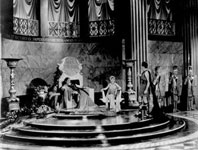
Sign of the Cross (1932)
Charles Laughton, Claudet Colbert, Fredric March
20x24 Toned Gelatin-silver fiber print
In
1932 at the height of the pre-code era in Hollywood, Cecil B.
De Mille created his masterpiece of Kitsch The Sign of the Cross.
This film quickly became notorious for its depiction of lesbianism,
homosexuality, bestiality, cannibalism and vice. All subsequent
excursions into ancient Rome including the titles in this exhibit
owe a debt to this film. It would take Federico Fellini nearly
three decades later to equal it with his breathtaking “Fellini
Satyricon”. This bizarre and lavish spectacle had over four
thousand extras, not to mention the use of half a dozen of the
nation’s zoos, to populate the massive set for the slaughter
of the Christians, lovingly photographed by Karl Struss.
There were three sequences by which this film’ over the
top reputation rests. The first takes place during the night of
the great fire of 64 AD as the mad emperor Nero plays his fiddle
while the city burns out of control below. De Mille, in a stroke
of genius, cast Charles Laughton, who in true gay abandon, gives
an acting tour de force as Nero. No one ever did gay abandon quite
like Laughton and it is a delight to see him squeal like a pig
at his own perverse villainy as the flames dance around the terrace
of his palace.
The second sequence is of course the wicked Empress Poppaea in
her bath of asses’ milk barely concealing her breasts as
they bob perilously close to the surface. The payoff comes when
the empress demands one of her attendants to join her for what
can only be interpreted as a lesbian encounter. Colbert recalled
years later that the milk was real and after a few hours the odor
was impossible to ignore and the set had to be cleared to clean
it out. The third sequence was nearly cut from the film. Frederic
March invites his latest conquest, the Christian girl Elissa Landi,
to a Roman orgy where upon the infamous lesbian dancer Ancaria
(Joyzelle Joyer) proceeds to indoctrinate the young girl into
the rites of Sappho by performing her specialty dance, a very
suggestive number for 1932. Most of the woman at the orgy are
wearing see-through gowns as the camera prowls about the room.
Four years later, all this was removed until the film was restored
to all its pre-code glory just a few years ago.
In spite of De Mille’s moralizing, this entire Roman costume
epic is highly entertaining,and quite unbelievable that he got
away with as much as he did in 1932. The Sign of the Cross remains
as a landmark achievement, not only for Cecil B. De Mille, but
as a masterpiece of kitsch.

Ercole
contro i tiranni di Babilonia (1964) Hercules and the Tyrants
of Babylon
Rock Stevens(Peter Lupus), Helga Liné 11x14 French Lobby
Card
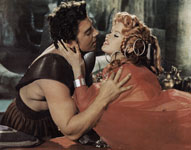
Gli
Amori di Ercole (1960) The Loves of Hercules
Micky Hargitay, Jane Mansfield 11x14 Silver-halide print
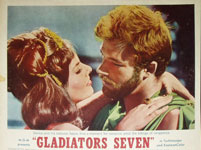
Los Siete espartanos (1962) Gladiators Seven
Richard Harrison Vintage US Lobbycard
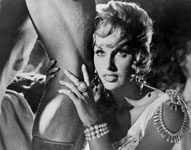
Ercole
e la regina di Lidia (1959) Hercules Unchained
Steve Reeves, Sylvia Lopez 11x14 Silver-halide print
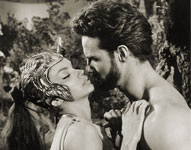
Fatiche
di Ercole, Le (1958) The Labors of Hercules aka Hercules
Steve Reeves 11x14 Silver-halide print
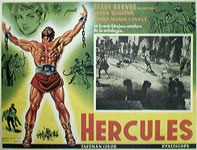
8) Fatiche di Ercole, Le (1958) Labors of Hercules
Vintage Mexican Lobby card
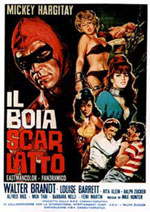
Il
Boia Scarlatto (1965) aka The Crimson Executioner, The Bloody
Pit of Horror
Vintage Italian Two-sheet 40x55 (linen backed)
By
1965 the sword and sandal film was drawing to a close but not
before this particular film known as The Crimson Executioner,
or Bloody pit of Horror in the United States, was released as
part of a drive-in double bill creating a substantial cult following
over the years. While it can be argued that this film is more
horror than peplum, the fact remains that The Crimson
Executioner straddles the line between the two genres.
Mickey Hargitay, a former Mr. Universe, was living in Italy at
the time as well as being the husband of Jayne Mansfield. They
even managed to star together in The Loves of Hercules (Gli Amori
di Ercole) in 1960. The Crimson Executioner address
to what effect the nature of bodybuilding can induce as a mental
aberration for a man so obsessed while also creating a substantial
subtext of homosexuality. Mickey Hargitay plays Travis Anderson,
a bodybuilder turned actor who made a number of sword and sandal
films in Italy before retiring to his castle populated by nothing
but muscular male servants in tight matching outfits. They serve
their master without question so one can also imagine the true
nature of such an arraignment. At one point Hargitay’s character
explains “I was forced to retreat to this castle!"
Mankind is made up of inferior creatures, spirirtually and physically
deformed, who would’ve corrupted the harmony of my perfect
body”
The popularity of this film as a camp classic rests almost entirely
on Mr. Hargitay’s performance as the crazed bodybuilder
and his alter ego the Crimson Executioner. Watching him oil up
his perfect body over and over again as his chest heaves up and
down in ecstasy while crying out for all to hear, “This
is my perfect body… my beautiful body“ is almost a
show unto itself. This film has been called a minor classic of
Queer Horror Cinema as well as a kinky hybrid of peplum and comic
book heroics. It is a time capsule of Italy in the sixties to
be sure. This film as well as The Loves of Hercules assures
Mickey Hargitay a place of honor in our pantheon of Greek and
Roman muscle men and the films that created the mythology of the
sons of Hercules.
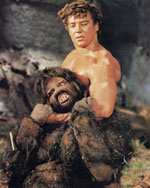 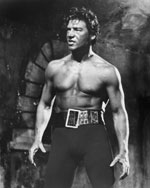  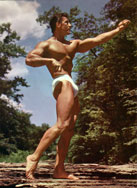 Mickey
Hargitay Mickey
Hargitay
Born
in Budapest, Hungary in January 1926 to parents who were in
show business in Europe, Miklos "Mickey" Hargitay
came to the US in the early 1950s. An accomplished bodybuilder,
Hargitay entered the Mr. America and Mr. World competitions
in the early 1950s and won the NABBA Mr. Universe in 1955, five
years after Steve Reeves won the title. Hargitay's show business
career heated up when he was discovered by Mae West, who added
him to her cast of bodybuilders in the 'Mae West Revue,' a 1950s
precursor of male stripper shows, along with Brad Harris, Gordon
Mitchell, and Reg Lewis. As rumor has it, Jayne Mansfield was
in New York rehearsing for Will Success Spoil Rock Hunter? when
she first saw Mickey Hargitay in West's revue in 1956. As the
story goes, a waiter asked Mansfield what she'd like that evening,
and her reply was, "I'll have a steak and the man on the
left!" Estranged from her first husband for several years,
after Mansfield's divorce they were married in January 1958.
While Hargitay was never strictly a sword and sandal actor,
he did make one film as Hercules, in the 1960 classic The Loves
of Hercules (aka Hercules vs. the Hydra with Jayne Mansfield.
Hargitay makes a exceptionally good Hercules and was one of
the only actors to not sport a beard for the part. Mansfield
portrays both a good queen (in a black wig) and an evil queen
(in a red wig). Mickey brings the beefcake and Jayne brings
the camp to this dubbed Italian spectacle. The dubbing, in fact,
makes the film unintentionally hilarious to fans of Hargitay
and Mansfield. Nevertheless, the action in The Loves of Hercules
is very engaging, and the film is a solid entry in the sword
and sandal genre. The couple also acted together in Promises!
Promises! (1963; with Marie McDonald and Tommy Noonan) and Primitive
Love (1964; with Franco Franchi and Ciccio Ingrassia). But around
the time of the latter movie's release, after six years of marriage,
three children, and several films together, the couple divorced
in August 1964 (just months after the birth of their daughter,
actress Mariska Hargitay). Hargitay continued his acting career
throughout the late 1960s and early 1970s. His best-known film
is probably Bloody Pit of Horror, an interesting horror film
that contains some shockingly gruesome scenes given the period
during which it was made. Hargitay portrays Travis Anderson,
a reclusive former actor turned sinister murderer who systematically
tortures and kills a bevy of dimestore-novel cover models who
come to his castle, uninvited, for a photo shoot.

Peter Lupus
Born in Indianapolis, Indiana,
on June 17, 1932, Peter Lupus has had an on-again,
off-again film career. Before becoming an actor, Lupus had won
the titles Mr. Indianapolis (1954), Mr. Indiana (1960), Mr.
Hercules, and the world title of Mr. International Health Physique.
As with many bodybuilders of the era, he tried his hand at acting
and took roles in the Indianapolis Starlight Musicals series.
In addition, he did summer stock work in the east. His first
film role came in the 1964 release Muscle Beach Party.
In his first film, Peter Lupus (billed as Rock Stevens) portrays
Flex Martian, the biggest bodybuilder in Jack Fanny's (Don Rickles)
troupe of athletes. Look for famed bodybuilders Chet Yorton
and Larry Scott as fellow bodybuilders. Of course, the movie
stars the usual AIP beach movie regulars, such as Frankie Avalon,
Annette Funicello, John Ashley, Jody McCrea, Dick Dale and the
Del-Tones, and Candy Johnson. Others include beautiful Italian
sexpot Luciana Paluzzi, Buddy Hackett, Morey Amsterdam, and
Don Rickles. After production wrapped on Muscle Beach Party,
Lupus went to Italy to make five quickie sword and sandal movies
for AIP. Before
Muscle Beach Party was released by American International Pictures,
producer Samuel Z. Arkoff told Lupus to come up with a stage
name, stating that American audiences liked American-sounding
names; therefore, Lupus is billed as 'Rock Stevens' in his early
film appearances. He went back to using his real name when he
was cast in the role of Willy Armitage in the CBS TV series
Mission: Impossible (1966-1973).
Peter Lupus met his future wife, Sharon, in the late 1950s when
she visited the Indianapolis gym that Lupus owned. They were
married in 1960 and have a son, Peter Lupus III, who is also
an actor. For a number of years, Lupus has been a vitamin company
representative and spokesman in the Hollywood Hills area, but
he occasionally accepts small parts in films and TV shows. Now
over 70 years old, Lupus is still working out and is in great
shape, only 10 pounds off his early 1960s weight of 250 pounds.
At 6'4", Lupus was one of the more physically imposing
sword and sandal actors.

Ercole al centro della terra (1961) Hercules in
the Haunted world
Vintage German Two-sheet 35x47 (linen backed)
Hercules in the Haunted World
is considered by many to be the best of the sword and sandal
epics primarily because of its director, the now legendary Mario
Bava. Bava was the cinematographer for both of the Steve Reeves
Hercules films and eminently qualified to helm just about any
kind of film where imagination and special effects were required.
Mario Bava came to Hercules in the Haunted World immediately
after astonishing the film world with his masterpiece La Maschera
del Demonio known in the United States as Black Sunday. Bava
proved he could master black and white and now he was about
to prove the same with color photography, for this Hercules
would be the most psychedelic of all the Hercules films to follow.
Bava had just worked on the special effects unit on “Hercules
and the Captive Women,” which also featured another former
Mr. Universe, British bodybuilder Reg Park, replacing Steve
Reeves in the title role. Mr. Parks was runner up to Steve Reeves
in the Mr. Universe competition a few years back and then went
on to win the title three more times.
Hercules in the Haunted World is filled with
gorgeous imagery that is quite dazzling at times. This time
Hercules must descend into Hades to save his lady fair from
the clutches of the evil Lord of the undead. Lyco, played by
Christopher Lee. Mr. Lee had just created a sensation as Dracula
for Hammer films production of Horror of Dracula so naturally
his character was in need of human blood at some point in the
proceedings. Hercules was shot in three short weeks at Cinecitta
during the summer of 1961. Christopher Lee recalled how much
fun he had playing opposite Reg Park as they both got a case
of the giggles hurling paper mache rocks at one another.
Mario Bava has created a masterful fantasy in bold rich colors
with compositions of rare beauty for a genre that benefited
greatly from his peerless mastery of photography and special
effects. Hercules in the Haunted World is one of the must see
films in the canon of sword and sandal epics. It is also a classic
in the realm of fantasy cinema.
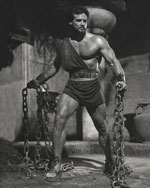 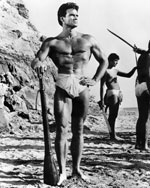 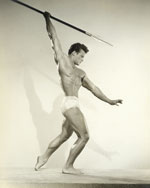 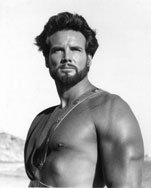
Steve
Reeves
Though he did not possess
a Herculean acting talent, bodybuilder Steve Reeves certainly
had a Herculean physique, and made good use of it to play some
of filmdom's most famous mythological heroes during the late 1950s
and early 1960s. Reeves was born on a cattle ranch in Montana
in 1926. His father died in a farming accident, and at age six
months, Steve won his first fitness title as "Healthiest
Baby of Valley County." His family moved to California later
that year. He joined the Army, where his job was loading boxcars
and trucks, and constantly worked out at the gym in his free time.
His body developed quite rapidly and he decided to pursue bodybuilding
professionally. Following Army service, he won "Mr. Pacific
Coast" in Oregon in 1947 and, eventually, "Mr. America",
"Mr. World" and "Mr. Universe". He traveled
to New York, where he studied acting, and afterwards made his
way to Hollywood. He didn't get many parts other than bulging
pectorals in the background of various musical spectacles and
costumers, although he did manage to snag a role as a detective
in infamous director Edward D. Wood Jr.'s Jail Bait (1954).
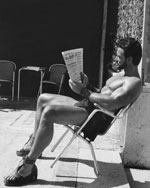   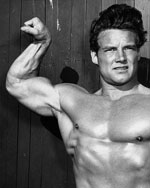
Small parts on TV came his way, but they too were mostly posing
bits or walk-ons. Disappointed, luck finally came his way when
Italian film director Pietro Francisci saw him play Jane Powell's
boyfriend in Athena (1954) and persuaded him to go overseas to
play the title role of Le (1958) Though critics dismissed the
film as "muddled mythology" (and worse!), the public
loved the sword-and-sandal epic despite its poorly-dubbed sound
track and Steve became an "overnight" star. Sequels
followed, none any better or worse. Reeves paved the way for other
pumped-up hopefuls (Ed Fury, Mark Forest, Reg Park) to seek fame
and fortune playing absurdly muscled mythological figures such
as Samson, Ursus and Colossus, but nobody topped Steve in popularity.
A shoulder injury forced his retirement, and he spent the remainder
of his life promoting drug-free bodybuilding while living on a
ranch and breeding horses. He died of lymphoma at age 74 in 2000.
Read
an Interview with Steeve Reeves here
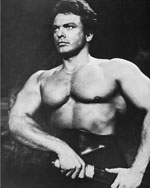
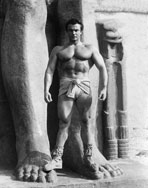
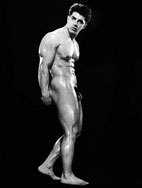 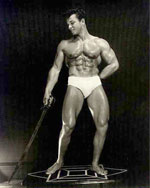 Mark
Forest Mark
Forest
Born Lou Degni in Brooklyn,
New York, in January 1933, Mark Forest began bodybuilding at the
age of 13 after being inspired by physical culture magazines.
Later, Forest and his brother worked with the physically handicapped
by developing exercise programs for them. Forest competed for
the 1952 Mr. America title and finished 27th, a remarkable feat
for a 19-year-old. Before entering films, he appeared in some
nightclub acts as the "strength premise." Forest was
named "Mr. Venice Beach" in 1954, and he came in second
in the "Mr. Muscle Beach" competition during the same
year. Forest was the second American actor, after Steve Reeves,
to be recruited by Italian producers to star in sword and sandal
films. He is a third-generation Italian-American, and some of
his films were made in Naples, Italy, the area from which his
grandparents came. He used the money he made making gladiator
movies in Italy to study Opera. Currently teaches opera in the
Los Angeles area.
back
more
home |











 Mickey
Hargitay
Mickey
Hargitay












 Mark
Forest
Mark
Forest